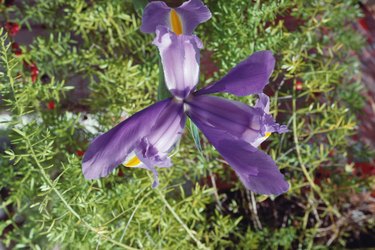
Irises are common perennials, grown for both their appealing foliage and their colorful blooms. Irises come in all the colors of the rainbow—in fact, "iris" in Greek means "rainbow." There are many species of iris, dwarf and Siberian, bearded and beardless. They bloom for only a week or two, though, so identifying irises by their flowers isn't always an option. Learning what iris foliage looks like allows you to identify irises all spring, summer and fall.
Identifying Iris Foliage
Video of the Day
Step 1
Look at the leaves. The most common irises have leaves that are flat and arranged in a fan shape, rising from a brown rhizome, or horizontal root. The leaves are usually stiff and a medium green color. They grow to between four and 36 inches tall. They are about one to two inches wide at the base, tapering to a point at the top. The veins are parallel to the edge of the leaves.
Video of the Day
Dwarf irises are formed the same, but usually only about three to six inches tall.
Some irises, like Dutch irises, grow from bulbs, so they their leaves grow out of the base in a cylinder. These typically have narrower, ribbon- or grass-like leaves.
Step 2
Look at where the plant is growing. Most irises need sunlight and moist, well-drained soil. There are a few exceptions to this, like the water flag, which needs a watery spot, or the Japanese iris, that needs a humus-rich, moist soil.
Step 3
Look at the flower, when possible. Irises can bloom from early spring to early summer, depending on the location, climate and variety.
There are more than 300 different species of iris in the world, so identifying a single species can be challenging. Most irises do have some shared characteristics. Irises usually have six petals. The most common varieties, Siberian and bearded irises, have three downturned petals, called "falls," and three petals that point up. They may have "beards," rows of colored hair along the center of the falls. The colors can vary from nearly black to pure white, including blue, purple, pink, bronze, and many that are more than one color.
Irises flowers grow on a single or branched stalk, from four to 36 inches tall. The flowers are followed by a seed pod, if the flower stalks are not cut back after blooming.
Step 4
Look up photos of irises on the Internet or in gardening books. Compare the plants you are trying to identify with the photos you find. Irises are distinctive plants. Their foliage slightly resembles other bulbs, but the flattened leaves in a fan-shaped arrangement are unique to irises. Dutch iris foliage is completely different from Siberian or bearded iris foliage, so if you find that the plant you are trying to identify is not a Siberian iris, check to see if it might be a Dutch iris.